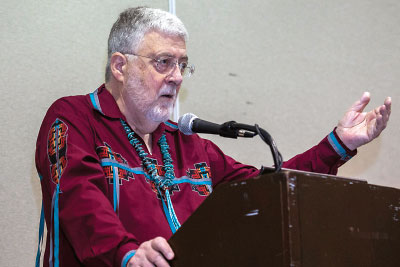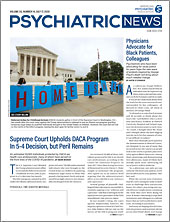The arrival of SARS-CoV2 to the Navajo Nation brought with it not just disease and death, but also worry, fear, anxiety, and depression to a people whose cultural heritage raised their risk to COVID-19 but also highlighted their resilience to adversity.
The Navajo people see themselves as part of extended families and still larger clan groupings, which usually serve as sources of support in times of crisis, said Mary Roessel, M.D., a Navajo psychiatrist with the Indian Health Service (IHS) in Santa Fe, N.M. An ethos calling for taking care of one’s own grandparents expands to encompass all elderly persons, she said. “So we feel collective worries and concerns about people across the Navajo Nation.”
However, those bonds may also prove problematic when infection stalks the land. The traditional presence of multigenerational families means that once the virus has entered a household, isolating the patient is difficult. Many Navajo live in remote settlements, often without running water, making recommended frequent handwashing a problem. Distance hampers monitoring and access to care. In addition, Indians in many tribes across the United States live with diabetes, obesity, and cardiovascular disease, all of which increase risk for COVID-19 infection or its severity.
Physical Distancing Particularly Hard for American Indians
For many reasons, the COVID-19 pandemic struck the Navajo especially hard, said Roessel in an interview. The Navajo reservation stretches across an area the size of New Jersey, covering parts of Arizona, New Mexico, and Utah, but it has a population of just 173,667 (2010 census). At press time, 7,320 tribal members were diagnosed with the disease. By comparison, the next largest grouping of cases came in the IHS’s Phoenix Area with 1,920 cases, but that covers all of Nevada and the rest of Arizona and Utah.
Managing the arrival of COVID-19 in the Navajo Nation included finding how to name the disease in a way that made cultural sense, said Roessel. It soon became, in Diné, the language of the Navajo, Dikos Ntsaaígíí-19 or “The Big Cough,” a phrase that helped put COVID-19 into context and thus to educate people about its symptoms.
Other cultural supports like the spiritual healing power of traditional tribal ceremonies have been affected by the pandemic.
“Ceremonies depend heavily on the participation of extended families, and that conflicts with social distancing,” said Spero Manson, Ph.D., a professor of public health and psychiatry and director of the Centers for American Indian and Alaska Native Health at the University of Colorado in Aurora. “Given the collective nature of American Indian societies, social distancing puts at risk the sense of self and personhood.”
COVID-19 is not the first pandemic to sweep through the American Indian populations, and the past has left its mark on the present.
“After the Spanish flu of 1918 wiped out whole villages in Alaska, orphaned children were rounded up, relocated out of the territory, and sent to special boarding schools, introducing enormous dislocation culturally, socially, and familialy for many of these children,” said Manson, who is a Pembina Chippewa. “As a consequence, people developed an enormous distrust of the federal government in the context of pandemics and have suffered in ways that have reverberated for generations.” Fears of relocation were reawakened when tuberculosis epidemics struck in the 1930s and 1940s, and adults were sent away to sanitariums. Many people avoided seeking medical help as a result. Today, when local facilities can’t handle severe cases, some Navajo patients are sent to hospitals in Albuquerque, N.M.; Flagstaff, Ariz.; or Phoenix. Even that seemingly routine shift can stimulate fears of losing contact with their families.
Pandemic Adds to Population’s Stigma
The COVID-19 pandemic has brought stigma to many minority groups, who have been accused of originating or spreading the disease. As recently as 1993, the hantavirus outbreak in the Southwest was initially blamed on the Navajo, said Manson. “The connection between stigma and its emotional and psychological consequences is well established, individually as well as collectively.”
These nightmares reverberate with each disease outbreak. American Indians face an extensive burden of historical trauma and discrimination, one that affects their economic status, educational attainment, and living conditions and led to poor health care and lack of information to make decisions. Tribal members have higher than usual rates of depression, posttraumatic stress disorder, adverse childhood experiences, addiction, and suicide. The physical distancing required to prevent COVID-19 only contributes to those risks.
“The rate of current trauma is about 70%, which only exacerbates the underlying substrate of historical trauma,” said Manson in an interview. “COVID-19 just layered on additional stress and [created demands that] suddenly exceeded the available resources.”
Indian populations in the northern Great Plains—in states like Iowa, Nebraska, North Dakota, and South Dakota—so far have not been hit so dramatically with the virus as those in the Southwest. However, the area faces similar difficulties in controlling the spread of the disease.
Historical Inadequacy of Health, MH Resources Exacerbated by Pandemic
Not all reservations have hospitals, and those that do exist are not well equipped to handle a surge of intensive care patients, said Donald Warne, M.D., M.P.H., a professor of family and community medicine and director of the Public Health Program at the University of North Dakota in Grand Forks. Severely ill patients must be transported to private hospitals, often hundreds of miles away. “The infrastructure across the board is inadequate, and therefore the response is inadequate.”
Health care for most Indian reservations is managed by the IHS or contractors it pays under another program, called PL93-638. The IHS realized early delays in its response, but it was expanding testing capacity, access to remdesivir to treat hospitalized COVID-19 patients, and supplies of personal protective equipment, according to a May 14 teleconference with Rear Adm. Michael Toedt, M.D., chief medical officer of the IHS.
“The IHS is responding to COVID-19 with an all-hands-on-deck approach to address the potential surge in hospitalized and critically ill patients,” said the IHS in a June 2 statement announcing the formation of a Critical Care Response Team to bring in additional outside medical personnel to local clinics. “The IHS received over $2.4 billion in new funding to provide resources that will support a wide range of COVID-19 response activities across the Indian health system.”
The IHS serves about 2 million people but is underfunded compared with other federal health care systems, Warne told Psychiatric News. For instance, Medicare spending per beneficiary is $13,185; Medicaid spending per enrollee is $8,109; while the IHS is able to spend only $4,078 per user. Most of that pays for direct clinical services, so there is less for public health, which only gets ramped up during crises.
The IHS’s resources for mental and substance use disorder treatment were sparse before the pandemic but are now seriously strained, said Roger Dale Walker, M.D., professor emeritus of psychiatry at the Oregon Health Sciences University, director of the One Sky Center in Portland, and former speaker of the APA Assembly. “The IHS could address maybe 40% to 50% of the need on good days, and I would not call these the good days. That puts the IHS in a very bad bind.”
American Indians and Alaskan Natives who meet state eligibility standards can also receive Medicaid coverage, even if they are eligible for services through the IHS or at tribally operated (638) facilities.
“The shortcomings of the IHS are magnified in the Great Plains,” added Warne. “In South Dakota, the Medicaid system for mental health is coordinated though the state’s community mental health centers, of which zero is located on reservations. That places tribal members at a severe disadvantage because they have less access to local services. The system is designed to have poor outcomes.”
Problems Can Be More Severe in Urban Areas
American Indian life is not limited to the reservations, and about 60% now live in urban areas. They may have better access to health care in cities but also may be disconnected from families back on tribal lands. Many are homeless. Like members of other racial and ethnic minorities, they face greater health disparities, and they are more dispersed and less defined geographically than their peers on reservations, said Daniel Dickerson, D.O., an associate research psychiatrist at UCLA and an addiction psychiatrist at the American Indian Counseling Center in Cerritos, Calif., a suburb of Los Angeles.
“This can lead to even greater feelings of isolation and disconnection and less social support,” said Dickerson in an interview. “I believe that COVID-19 has affected this population, but I’m not sure of the extent.”
To understand part of that problem, he has received a research grant to analyze the effects of the pandemic on urban American Indian youth.
Providing Care Now and Looking to Future
During the pandemic, Walker has coordinated online discussions among a group of mental health clinicians, mostly social workers and counselors, who care for American Indian populations. One frequent topic is advising parents on how to help their children get through the pandemic.
“Children need structure and support,” he said. “When the family is under stress, the first thing you want is to have some structure that can get them through each day: predictable bedtimes, food, and behavior to keep them on track and derail problems.”
He also recommended that mental health workers call their patients regularly, simply to ask how they are doing. “You don’t need to talk about mental health. Ask what their needs are and if they are safe, just so they know you care about them.”
Roessel still reports for work at the Santa Fe Service Unit of the IHS but otherwise has switched to phone sessions with existing patients, except in urgent cases. Telemedicine services make patients more reachable, she said. “It eliminates transportation problems. I feel like I’m still connected to patients, and I’m thankful that they still want to talk.” She also provides informal support to clinicians who go out to smaller reservations to do COVID-19 testing. They face higher risk and thus incur greater emotional strain.
Walker looks forward cautiously to the day when schools will reopen and life edges back toward normal.
“We must maintain an appreciation for the way this virus works,” he said. An episode like COVID-19 produces anxiety and fear in a community that already struggles with trauma. Re-entry requires that everyone feels protected.
“We need a public health model that is developed and present for the next outbreak,” he said. “We should never be caught lacking equipment or protective supplies, and we must provide support for communities.”
Aside from addressing the pandemic, Warne has worked to build capacity by expanding the number of American Indian health care professionals. He directs the University of North Dakota’s Public Health Program and heads the school’s “Indians Into Medicine” program, which has graduated 240 American Indian physicians since it began in 1973. The university also offers M.P.H. and Ph.D. programs in Indigenous health.
COVID-19 may have brought disease and death to Native American peoples, but it has not crushed them, said Warne.
“Many of our community members draw strength and resilience from cultural connectedness,” he said. “In Lakota, we say ‘Mitakuye Oyasin,’ which means we are all related, so we need to promote social connections while we are physically distanced.”
Roessel agreed.
“This disease is disrupting the harmony of our world,” said Roessel. “It disrupts emotionally as well as physically. We will have to heal body, mind, and spirit afterwards, too.”
Prayer, families, and relationships provide resilience to the Navajo, she said. “Our culture, our spirituality, and our ceremonies are very much intact. We have endured worse and we can adapt to change.” ■
The IHS press release is posted
here.




